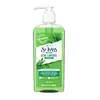What's inside
What's inside
 Key Ingredients
Key Ingredients

 Benefits
Benefits

 Concerns
Concerns

 Ingredients Side-by-side
Ingredients Side-by-side

Salicylic Acid 2%
MaskingWater
Skin ConditioningSodium Laureth Sulfate
CleansingGlycerin
HumectantCocamidopropyl Betaine
CleansingPropylene Glycol
HumectantDisodium Laureth Sulfosuccinate
CleansingParfum
MaskingPhenoxyethanol
PreservativeAmmonium Chloride
BufferingPEG-150 Distearate
EmulsifyingMenthyl Lactate
MaskingDisodium EDTA
Iodopropynyl Butylcarbamate
PreservativeMelaleuca Alternifolia Flower/Leaf/Stem Extract
Skin ConditioningAlpha-Isomethyl Ionone
PerfumingGeraniol
PerfumingHexyl Cinnamal
PerfumingLimonene
PerfumingLinalool
PerfumingCI 19140
Cosmetic ColorantCI 42090
Cosmetic ColorantCI 17200
Cosmetic ColorantSalicylic Acid 2%, Water, Sodium Laureth Sulfate, Glycerin, Cocamidopropyl Betaine, Propylene Glycol, Disodium Laureth Sulfosuccinate, Parfum, Phenoxyethanol, Ammonium Chloride, PEG-150 Distearate, Menthyl Lactate, Disodium EDTA, Iodopropynyl Butylcarbamate, Melaleuca Alternifolia Flower/Leaf/Stem Extract, Alpha-Isomethyl Ionone, Geraniol, Hexyl Cinnamal, Limonene, Linalool, CI 19140, CI 42090, CI 17200
 Reviews
Reviews

Ingredients Explained
These ingredients are found in both products.
Ingredients higher up in an ingredient list are typically present in a larger amount.
Salicylic Acid (also known as beta hydroxy acid or BHA) is a well-known ingredient for treating skin that struggles with acne and clogged pores. It exfoliates both the skin's surface and deep within the pores to help clear out buildup, control oil, and reduce inflammation.
Unlike AHAs (alpha hydroxy acids), salicylic acid is oil-soluble. This allows it to penetrate into pores which makes it especially effective for treating blackheads and preventing future breakouts.
Salicylic acid is also known for its soothing properties. It has a similar structure to aspirin and can calm inflamed or irritated skin, making it a good option for acne-prone skin that is also sensitive.
Concentrations of 0.5-2% are recognized by the U.S. FDA as an over-the-counter topical acne product.
It can cause irritation and/or dryness if one's skin already has a compromised moisture barrier, so it's best to focus on repairing that before introducing this ingredient into your routine.
While salicylic acid does not increase sun sensitivity, it’s still important to wear sunscreen daily to protect your skin.
If you are looking for the ingredient called BHA or Butylated Hydroxyanisole, click here.
Learn more about Salicylic Acid